|
Southern Patagonia
Argentina, here I come!
We finally arrived at the 7-km distant port in the morning drizzle. I was the first to arrive. We removed the bags from the bikes, took them on board and the staff lowered them into the hold. We carried the bikes up the gangplank on to the boat, the sailors themselves arranged them and tied them up in the bow. Then they kept us in some suspense, as it was uncertain if the wind would allow a safe sailing. I assumed that this was a marketing trick to make the voyage more enjoyable. After all, after loading everything, they would not have unloaded it all again, that stood to reason. Of course, we left the port, but the wind in the narrow canal we had to pass through played with the boat for half an hour, while the Captain had his hands full. So I had to admit that they were right – a really strong wind here could flip the boat against the rocks so they had to be careful. We arrived at Canselario Mancilla at noon. After obtaining the Chilean exit stamps, we began to climb the terrible dirt road covered in loose gravel, in the direction of Argentina. The Italian climbers threw themselves into the task, their physical fitness was amazing. Paul had a difficult time on his bike with trailer, which is far from ideal in such a terrain. The Italians were hungry and stopped in the woods, so I took the lead. Unfortunately, this meant that the distance which I had to cycle back was the longest, because when I reached the river, I saw that the bridge was accessible only through the airport field, which I had cycled around. So I back-tracked for over a kilometer, met up with my companions and told them that I had forgotten my passport at the Customs office. They cycled on, but after 10 meters I stopped them, told them the truth and directed them back to the entrance of the field airport so that we could all continue.
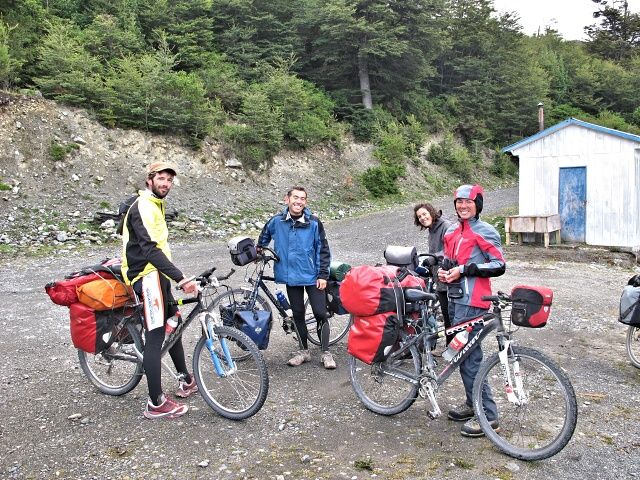
[Port Bahamondez] Italian couple in front, French couple behind

[ O'Higgins Lake] Sailing over the lake
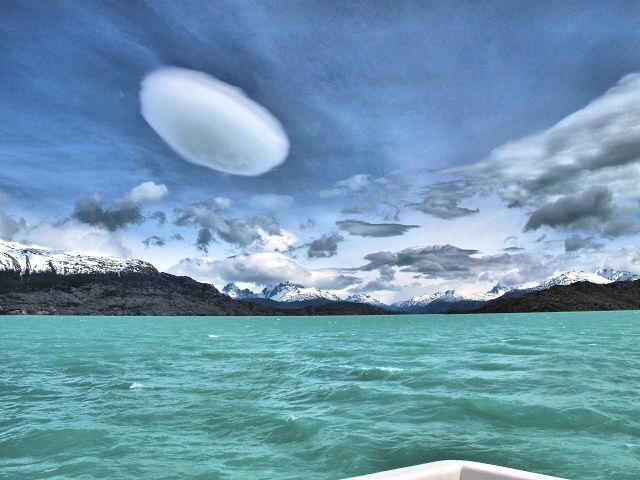
[ O'Higgins Lake] This UFO-like cloud appeared close to Candelario Mancilla
A Dramatic Change of Route
A sign announced that we had entered Argentina, but we would have known this even without it. The passable road ended and, instead, a difficult footpath in the overgrown cranberry vegetation began. Trees lying across the road followed, some of them - those whose diameter was close to one meter, we managed to move with the combined strength of two or, in the case of Paul, three persons. A bike trailer is a problem. The rain poured down. I kept right behind the Italians who had traditionally left first. We gradually lost our timidity of getting our shoes wet, as wading was necessary. Fortunately, I at least had taken off my socks in advance. For some time, we splashed around in the mud, pushing the bikes through water half a meter deep. Several times I had to remove the bags to get up a steep and slippery slope. To my amazement, I found it was already 5.45 p.m. and the boat was leaving at 6 p.m. I began to pedal hard and soon reached the final stage, with another treat in store – the path changed into a trench, sometimes a meter deep, into which at times even both front bags did not fit, so I had to carry one on my back. I was pushing the bike from above as a puppeteer does with a puppet, my feet were sliding, the brakes had no effect in the slimy mud, really fun. I tried to direct the bike on to the narrow edge, but could not keep my balance, the bike turned over and dropped into the ditch, handlebars first. In addition, during the fall three cogs of the biggest gear wheel struck the outer side of my right ankle. Blood streamed from it and I realized too late that it ain’t no use to rush. I admired the strength with which I was able to haul the fully loaded bike out of the meter-deep narrow ditch.
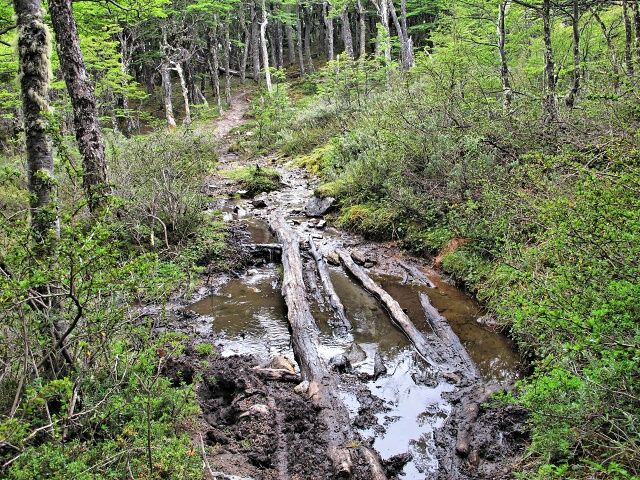
[The route to Argentina] It was raining, there was water everywhere
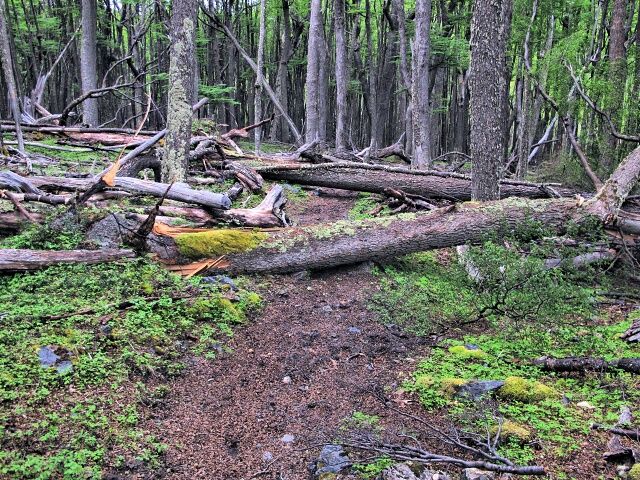
[The route to Argentina] We had to help each other when passing over fallen trees; we carried the bikes over in threes
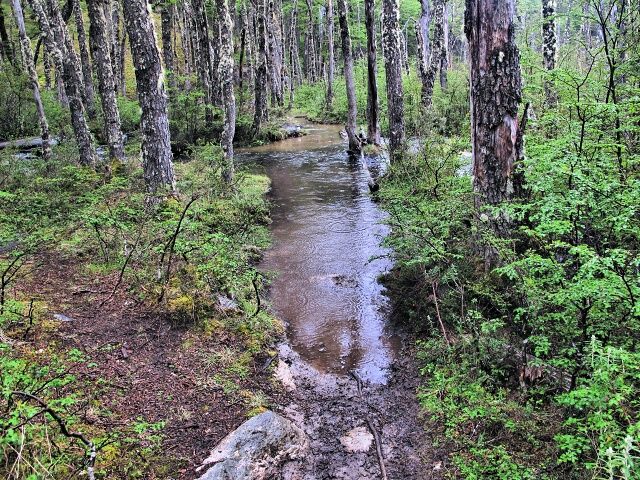
[The route to Argentina] The road was flooded with approx. half a meter of water
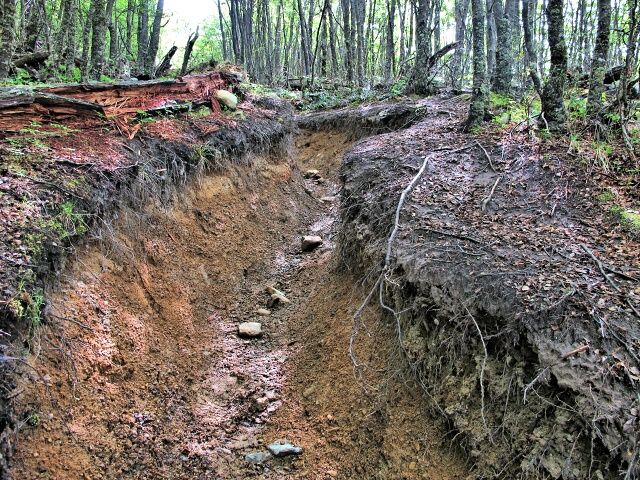
[The route to Argentina] The final “treat” was the descent to the lake in a ditch approx. 1 meter deep, sometimes so narrow that it was impossible to pass through it with the bike and bags
I received several photos from Paul, illustrating the conditions of his passage to Argentina. The following five photographs were taken by Paul Gareau, who describes his long trip in his blog www.PanAmericanTour.net.
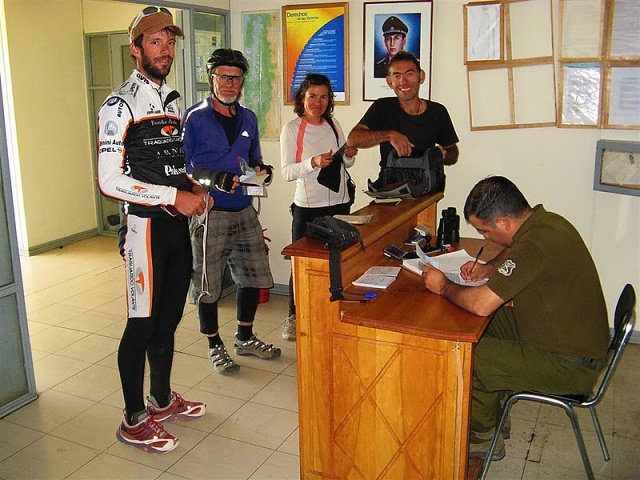
[Candelario Mancilla] At Chilean Customs

[The route to Argentina] Exemplary international collaboration in surmounting fallen trees

[The route to Argentina] At times the water was over my knees
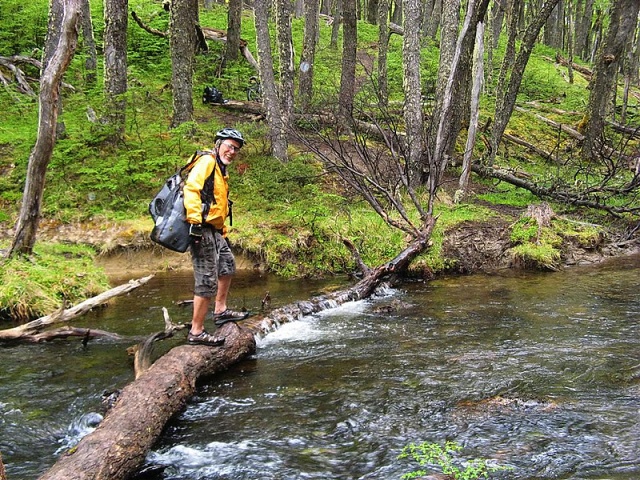
[The route to Argentina] I cross the brook on a fallen tree and am happy to have got the better of it
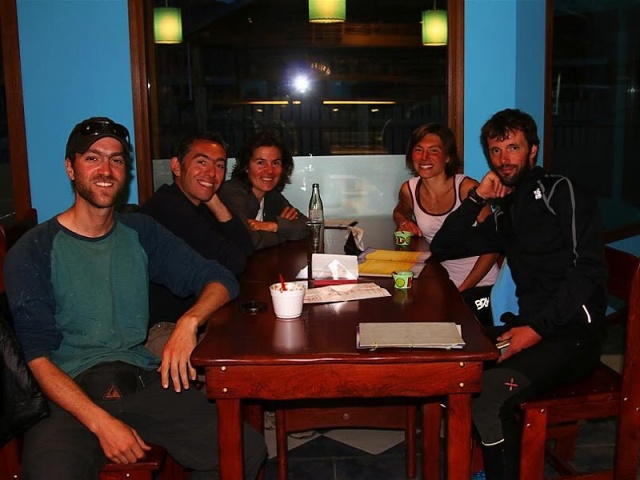
[El Chaltén] Paul (US) on the left, Franck and Sophia (FR) behind him, Serena with her partner (IT) on the right
Soaking wet, I arrived at the Argentinian Customs office. I took out my passport in its waterproof folder and gave it to them to remove for themselves. And, as had happened to me several times already, the officer turned to the first page with the photo, which was a U.S. visa, and began to copy the data, shaking his head about how stupidly the passport was arranged. So I told him that was a U.S. visa and that he would find the passport data on the last page. And then I added with a smile, that it was actually the same. He nodded importantly, turned to the last page of the passport, crossed out the line he had already written and started writing the same thing all over again, from the beginning.
Accommodation Problem Solved
I arrived at 5.55 p.m., the Italians had already been waiting for 45 minutes, but the boat had not yet arrived and and would not be arriving due to the bad weather. In half an hour, our whole group had arrived in the torrential rain. We stood in the Customs shed, which also contained a boat trailer and a lot of torn mattresses. I told the women, who both spoke Spanish well, to persuade the officers to allow us to move the trailer out into the rain and to pitch our tents in the shed. They failed to persuade them, but returned to say that there was a refugio, without running water but with electricity and gas for the cookers, and that we could sleep there for 5 USD (i.e. for a song). So we settled in there. The drenched pedestrians arrived in the dark. So the entire company from El Mosco was together again.
Waiting in Vain
In the morning, we were told that the boat would arrive at 11 a.m. At 2 p.m. the pedestrians set out on the 15-km long trek around the lake, which takes six hours on foot. While waiting, we successfully dried our wet belongings from the previous day, but this was the only positive event. It was Monday when the boat did not normally operate, but they would supposedly take the trouble of sailing the 12 km across the lake for us. However, they did not arrive, claiming that they had technical problems and would come in two days' time, if at all. Considering that the ticket for the 45-minute voyage cost 25 USD, their service sucked. I also thought that there was no technical fault, but that it had not been worthwhile for them to transport only six people and so they were waiting to see if anyone else wanted to use their transport in the opposite direction as well.
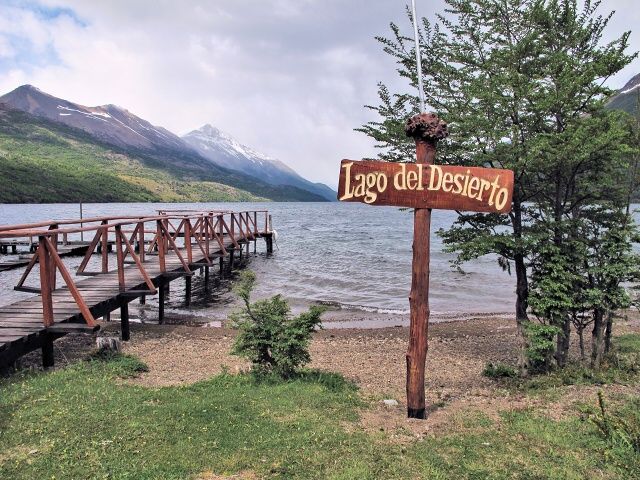
[Lago del Desierto] The port where we expected the longed-for boat
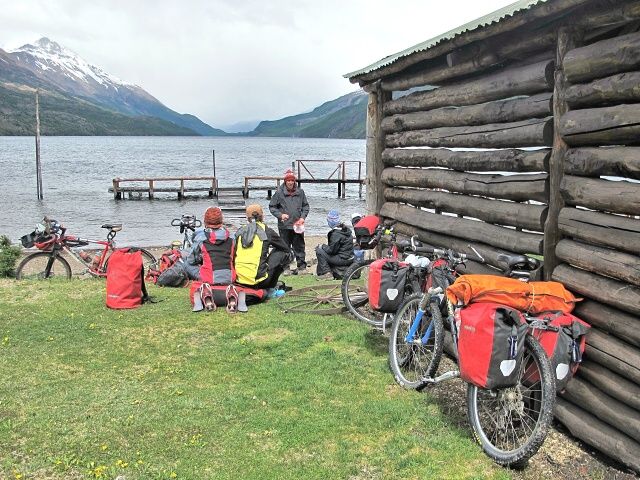
[Lago del Desierto] A hopeless wait for the boat
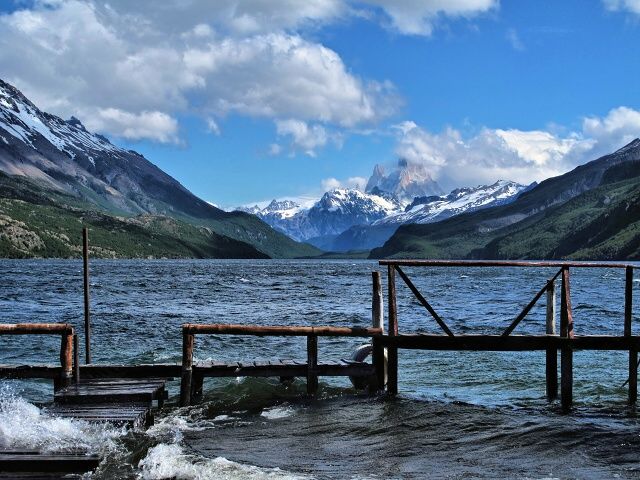
[Lago del Desierto] Fitz-Roy in the background with its glamour

[Lago del Desierto] The peaks of Fitz-Roy are the aim of many mountain climbers
Unwilling Mountaineer
We asked the Customs officials about the trail around the lake. They did not recommend it at all, saying the 15 km would take at least 12 hours by bike, there were high cliffs and narrow ledges above the lake. The Italians decided to go for it. My food supplies would have hardly lasted for one more day and so I also decided to trek. The boat sailing was unreliable, and after two days of starvation I might no longer be physically strong enough for the trek. In the morning, I unscrewed the pedals so that they could not injure my legs, stuffed the handlebar bag into an empty food bag and set out. It was a nightmare – incredibly steep ascents and descents, climbing rocks, balancing on a 30-cm ledge 15 meters above the water, fording streams and swamps, constant climbing over fallen trees. The loaded bike gave me an extremely hard time and after two hours I was totally exhausted. I recalled my father who had told me, “Do you know why the lazy man exhausted himself? He was unwilling to do the trip twice.” So I organized it accordingly. Instead of 15 km, I covered more than 40 km – I actually covered the track three times - first with the bike and front bags suspended on the rear wheel. Then I returned for the three rear bags to carry them to the waiting bike. I met about 15 young Argentineans halfway, who were looking for accommodation (although a hotel had been planned, it was not yet open). I sent them back, they realized that I was returning for my bags and offered to carry my luggage for me, so that I need only push the bike. And I, proud idiot, thanked them but refused their help, arguing that it would not be sporting. Well, am I not a priceless fool?

[Lago del Desierto] Me in the middle of the trek around the lake
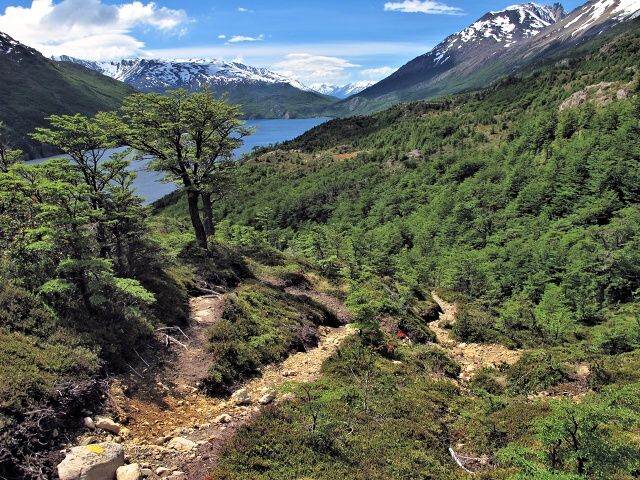
[Lago del Desierto] The tough climbs were gradually destroying me
Before 5.30 p.m. I heard the boat approaching across the lake, so I had set out on the trek in vain, my motivation was gone and I did not feel like continuing. I found a place to sleep, which was not easy. First, under a rock, but then I figured that stones might fall from the rock, so I moved on to a sloping, but safer place. I spent the whole night sliding over on to one side and pushing myself up to the other side again, but slept for a full 11 hours.
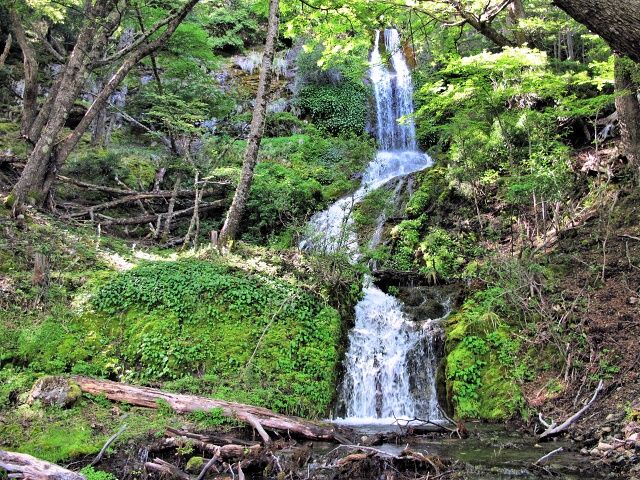
[Lago del Desierto] When trekking I passed several waterfalls; this one was the highest one
I checked the GPS and saw that the road on the southern shore of the lake was 1.4 km away, but it still took me three more hours. Finally the trek had taken me 13 hours. A good performance for someone in sandals, cautious at each step to avoid injury. Had that happened, I could have remained lying there for several days without any aid. The bike had an incredibly hard time, but the carpentry endured and I managed to protect the gears and gear-shift. I, myself, also suffered enough. On the next day a strained calf muscle on the left leg began to ache. I would try to cure it with a Priessnitz poultice.
Old Bunch in El Chaltén
I continued to El Chaltén on a partly very bad dusty road amidst beautiful surroundings. I found the only ATM in town, where I was able to withdraw cash, and met the Italian couple who directed me to the hostel where the rest of the bunch of cyclists were staying. So we hugged and praised each other and all was well again.
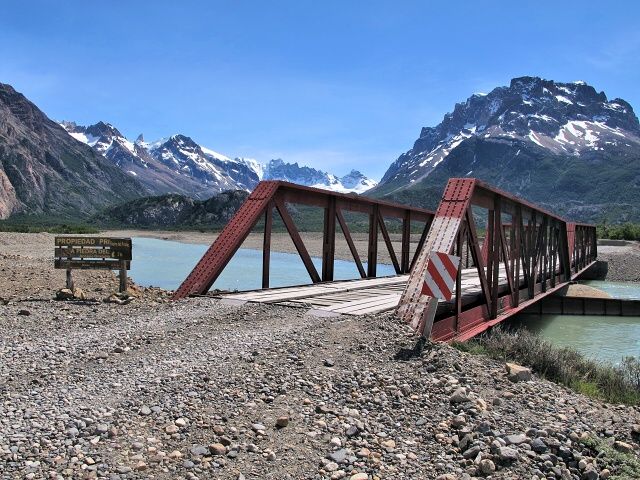
[Electrico River] The bridge over the Electrico River on the dusty road to El Chaitén
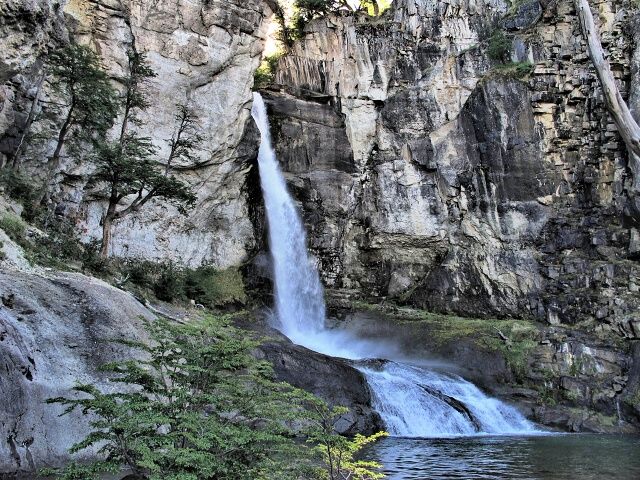
[Salto del Churrillo] Waterfalls near the road to El Chaltén
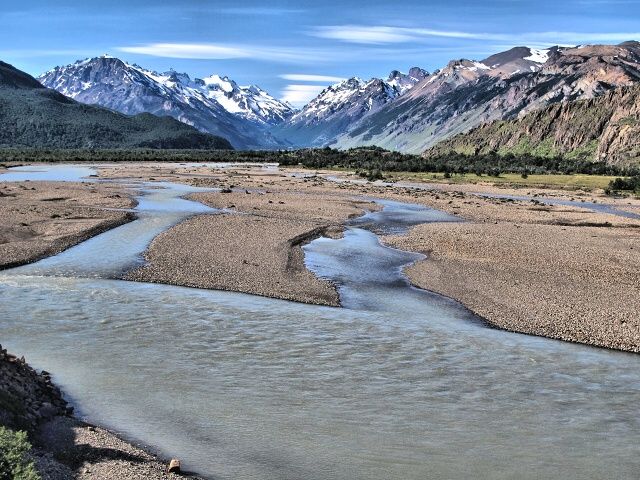
[Near Chaltén] Surroundings of the road to El Chaltén
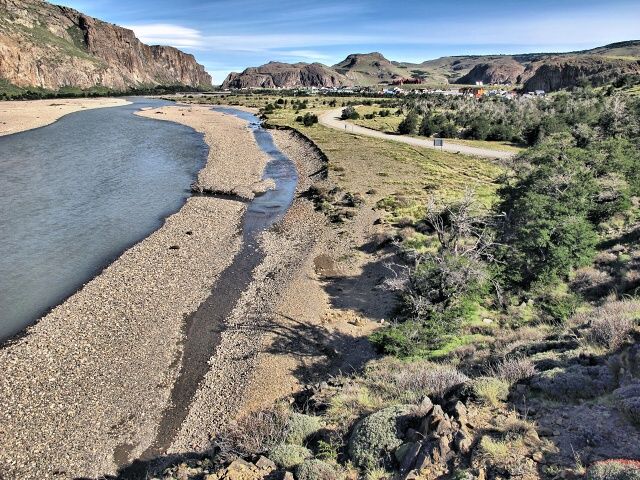
[El Chaltén] The town, something to eat and drink within view
Scottish Bard
A Scottish guy about my age, who was also staying there, took out his guitar and harmonica in the dining room that evening and began to perform. First, “Just Like A Woman” and then immediately “All along the Watchtower”, two Bob Dylan hits, and so I knew that we would be friends. We immediately uncorked some bottles and started – well, I did not sing as this would have spoilt the songs. I was recalling old songs, and he knew them all, lyrics and melodies, and played as if his life depended on it. The young people knew many of them but still were amazed. The Scotsman and I informed them haughtily that they knew shit about music and life in general because they had not experienced the sixties and nothing worthwhile had taken place in Rock music since then. And Yon enthusiastically recounted his Prague experiences to me, which revolved around the names of beers – Staropramen, Pilsner, Budvar—which he pronounced with a cute Czech accent. And he delighted me by saying that when he had first tasted Budvar, he reportedly told the Americans to stick their Budweiser up their......
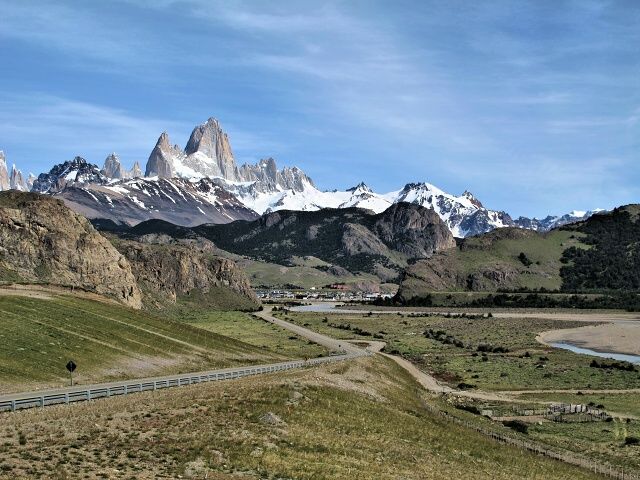
[El Chaltén] Impressive Fitz-Roy over the small town
Boredom, but far away
Although I had gone to bed late, I was wide awake next morning and put a Priessnitz poultice on my aching calf. I set off at 11.30 a.m. The senorita in the panaderia (bakery) surprised me with the information that it was impossible to cycle to El Calafate due to the incessant headwind. Well, this was forecast for the next day, so it did not bother me. I enjoyed the paved road and ideal cycling weather – almost no wind with cloudy skies, but no rain. Spoiled from Chile, I underestimated my water supply. The road had no access to lakes. The rivers were dirty gray or brown as manure. But fortune favored me, a passing car stopped next to me and a completely bald tattooed Italian jumped out. 14 days before, he had completed the ride from Alaska to Ushuaia, and so he shared his experiences. He asked if I did not need anything – I classically refused. He offered to at least give me some water and added a ham sandwich and a package of salted sticks to the PET bottle. I thought that I would shop at the intersection with Road 40, located 90 km from El Chaltén, but there was no bus stop there, let alone a gas station or store.
The route followed an almost flat, straight road surrounded by tedious pampas. Huge ice floes that had drifted far into the lake were interesting, but seen only at a distance. There was a minimal amount of traffic, so the only entertainment was provided by birds and sometimes a confused armadillo waddling across the road. I was only bothered by cycling without mirrors – one broke off by itself and the other was knocked off when my bike fell into the deep ditch before the Argentinian Customs office. Although one of the pedestrians had brought me the mirror and I had stuck it back on with silver tape, it did not stay in position and so it was useless. Out of habit, I kept looking to the left and right ends of the handlebars to know the buzz behind me – and there were no mirrors. The only sign of civilization was the El Leona Hotel beside the eponymous river, where I had dinner and bought a beer as a nightcap. In the meantime, the wind began to blow pleasantly behind me, so I cycled like Chiron. After 7 p.m. I searched for a place to sleep near the water. Close to the bridge over the Rio Leona, I left the road and pitched my tent on a grassy bank. I also washed in the river, but did not enjoy it much in the turgid water, so I did it rather quickly.
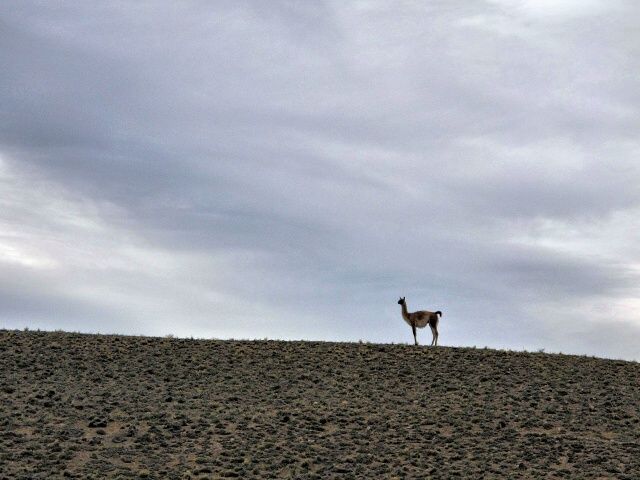
[Highway 40] A guanaco waits for me to pass, to be able to cross the road to see his/her friend

[Highway 40] Pampa and the mountain range in the background
An Offer not to be Refused
That night, I was woken by a furious onslaught of wind. I was forced to leave the tent and remove the towel from the handlebars so that it did not fly away. Well, it was clear that Patagonia was manifesting itself in full force. The morning packing up of the tent in the windstorm was quite a problem. For the first 50 km, the wind blew mostly from 4 o'clock to 5 o'clock, which was good. With the appropriate angle of my body, it drove me ahead. However, the last 32 km of the road turned westwards, so I had to face the storm. The wind power was also strengthened by the fact that the zipper on my windstopper jacket kept opening as the wind tore it from my body. And I praised the windstopper gloves, prophetically purchased in Santiago, without which it would not have been possible at all.
The wind was shaking me, I slouched over the handlebars as low as possible and, at a breathtaking average speed of 8 km per hour, I resolutely crawled into El Calafate. Several vans passed me and sometimes honked to offer me a ride, but I did not want to hitchhike. Indeed, I am a cyclist. When the last 15 km remained, a van stopped in front of me, two guys got out and threw the bike on to the van without asking me anything. So I jumped on after the bike and was glad about how it had happened. In this way, I had saved face and cyclist's pride, while not having to trudge for two more hours in the stupefying and exhausting gale.
El Calafate
This town of about 15,000 inhabitants is focused solely on tourists. And it can afford it – the legendary Perito Moreno Glacier is only 75 km away, as well as other natural attractions in the nearby Los Glaciares National Park. The result is that things here are relatively expensive. There are a lot of expensive outdoor stores, mainly for clothing because the climate is very harsh, due to the glaciers and relentless wind. And of course, accommodation prices were higher. However, in the off-season, which begins in December, the prices were still quite reasonable. I arrived rather hungry, so I bought half of the local supermarket, mainly fruit and vegetables, and stuffed them into my mouth in such quantities until I was finally satiated.
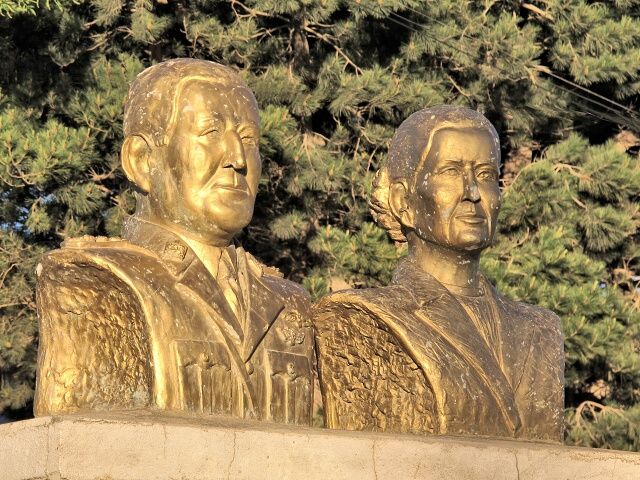
[El Calafate] The glory of Mr and Mrs Peron ruined slightly by time
The contused left calf muscle had received a Priessnitz poultice twice while I had not allowed it any rest, first cycling 134 km and then a little over 60 km, but I had got it moving against a strong wind. And once again my theory was confirmed that a well-tuned body heals itself. The muscle acknowledged that no protests expressed in the form of pain had helped and that it could expect no pampering, so it had restored itself and painlessly began to cooperate with the remaining parts of my organism.
Perito Moreno Glacier
I cast aside the idea of further cycling immediately after arriving in town. I did not need 75 more km in the stubborn headwind. I purchased a return bus ticket for quite a costly 100 Pesos (23 USD). To this, one had to add the entrance fee to the National Park, which was another 100 Pesos. And the boat trip to the glacier at 70 Pesos was pretty expensive. However, their marketing is done so well that almost everyone opts for the boat trip. The bus first stops at the dock, awaiting the completion of the hour-long tour and then travels to the observation platforms which offer a view of the glacier, probably better than that seen from the boat. So if you want to save money, skip the boat trip and you’ll have the same view for a total of 200 Pesos. The cheapest excursion with a tourist agency costs 350 Pesos plus 100 Pesos entrance fee to the NP, the only difference being that they take you by minibus instead of bus, and it includes coffee and a sandwich on the way.
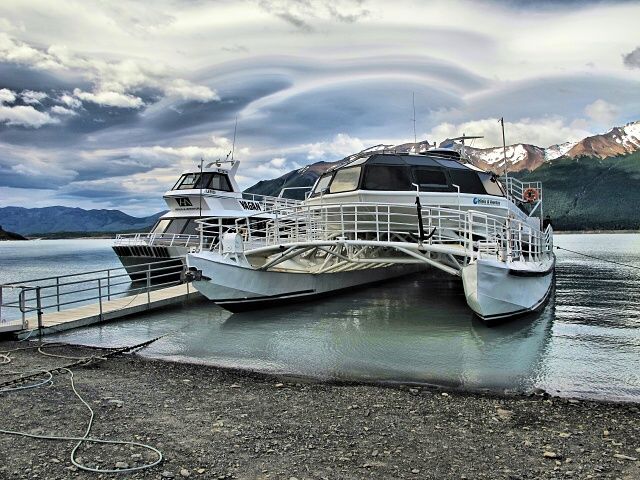
[Glaciar Perito Moreno] The "Victoria Argentina" catamaran is ready to sail
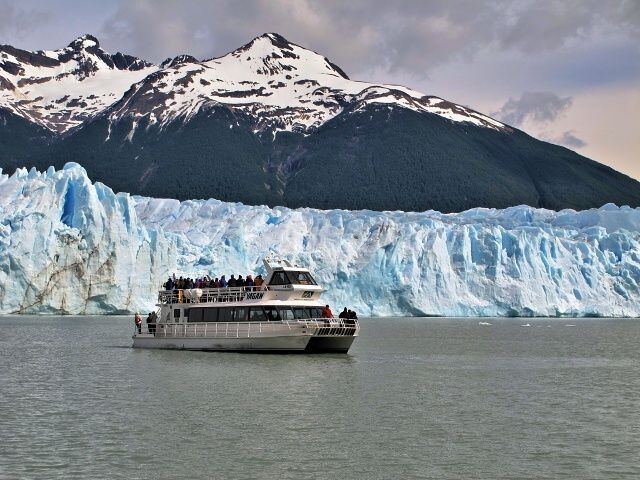
[Glaciar Perito Moreno] Another boat below the glacier
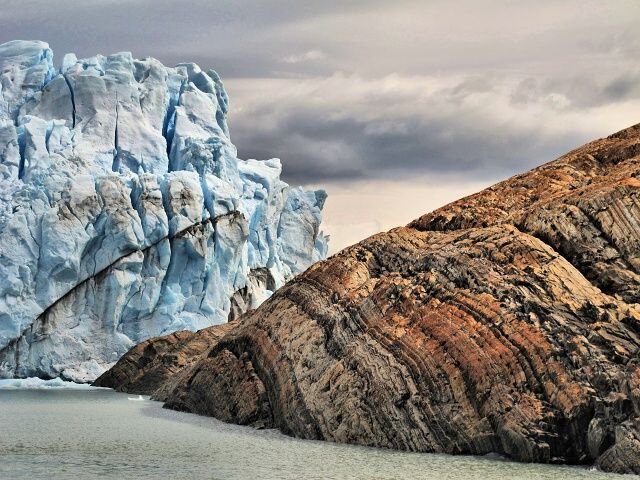
[Glaciar Perito Moreno] The glacier in contrast with surrounding rocks
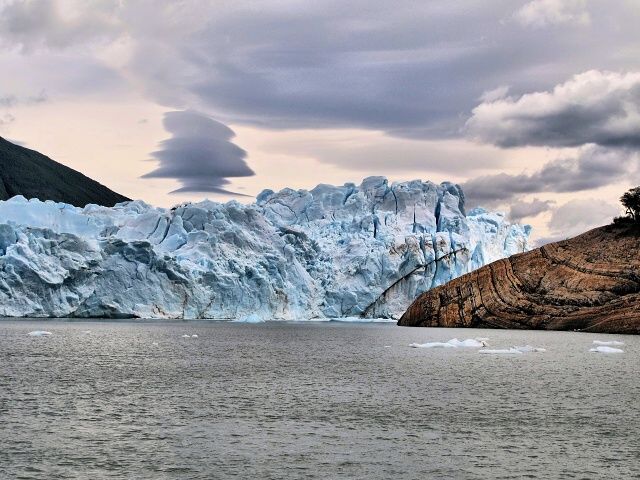
[Glaciar Perito Moreno] A cloud looking like the bust (of guess who?) appeared over the glacier
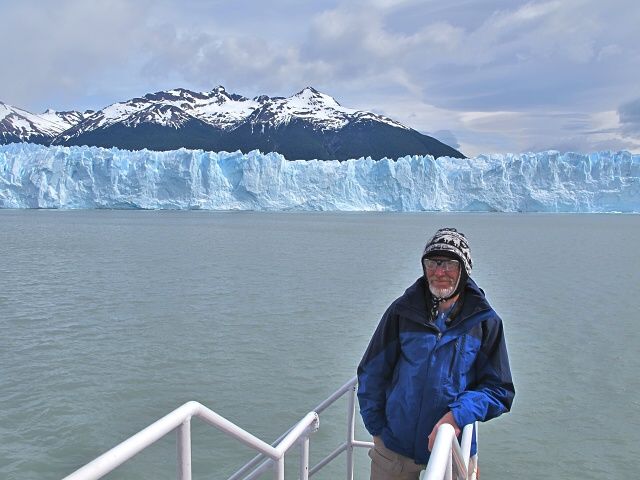
[Glaciar Perito Moreno] I couldn't resist the usual photo-taking, and had one taken of me as well

[Glaciar Perito Moreno] Our boat
But let’s leave money matters aside, because the glacier is simply an amazing natural phenomenon which literally stunned me by its size and unique beauty. In addition, it is a wonder which does not diminish but rather increases in size and spreads every year. The glacier tips are an indescribably rich blue color, the height of the glacier mass is about 50 meters. All the time, one hears sounds like cannon shots going off, produced by the pieces of ice falling off. Sometimes the pieces are so big that their fall creates waves of unexpected size. And when a flock of condors fly over all this with their forked wings, every sensible little man realizes how kind Nature is to allow him to spend some time in these incredible surroundings.
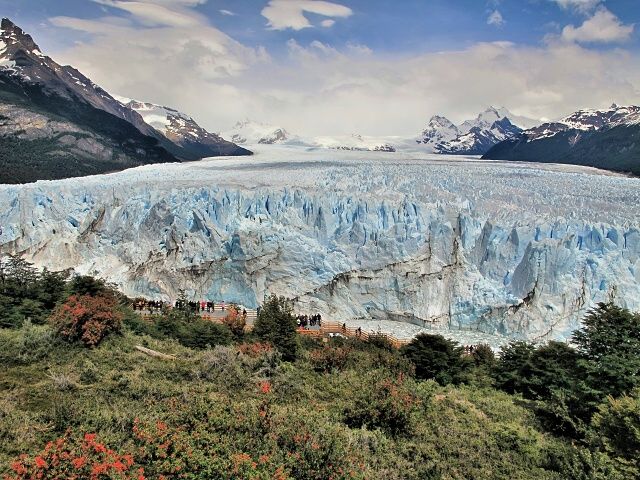
[Glaciar Perito Moreno] The general view stunned me
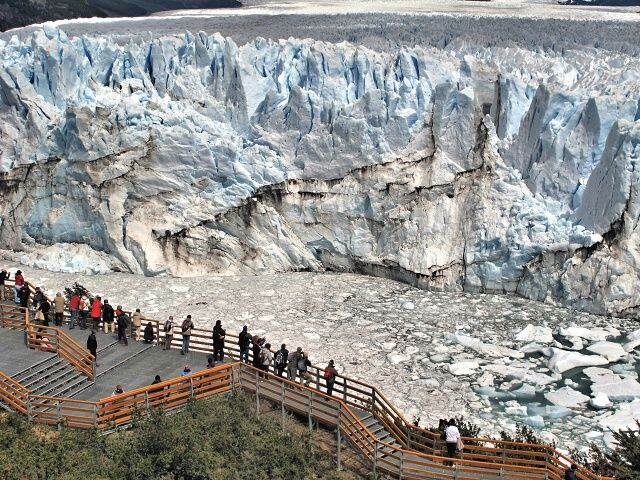
[Glaciar Perito Moreno] You can be fascinated by the glacier from the observation platform for several hours without being bored
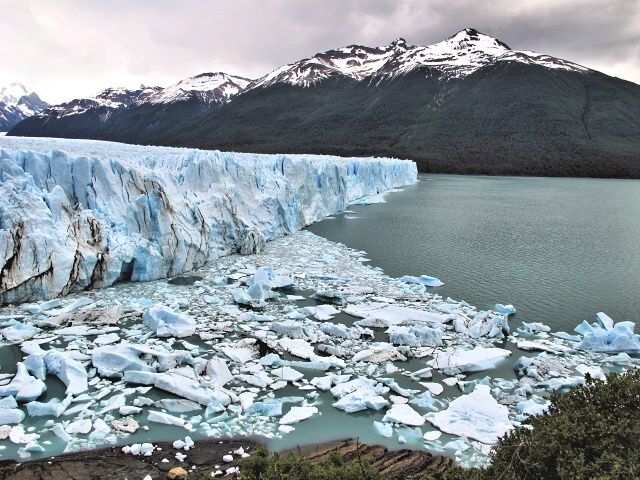
[Glaciar Perito Moreno] Fallen pieces of the glacier piling up in the bay
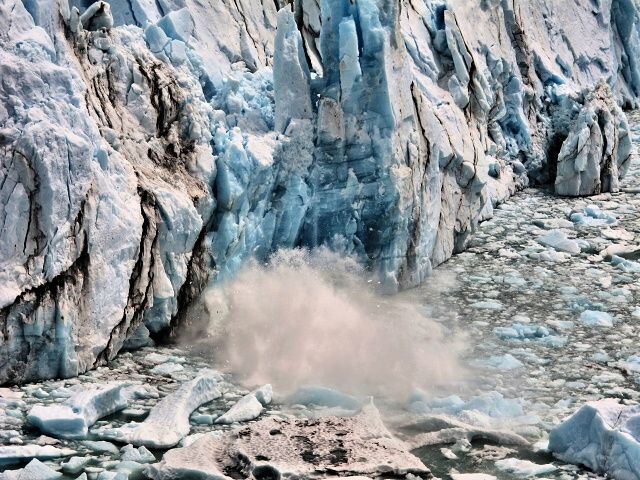
[Glaciar Perito Moreno] Another fallen piece
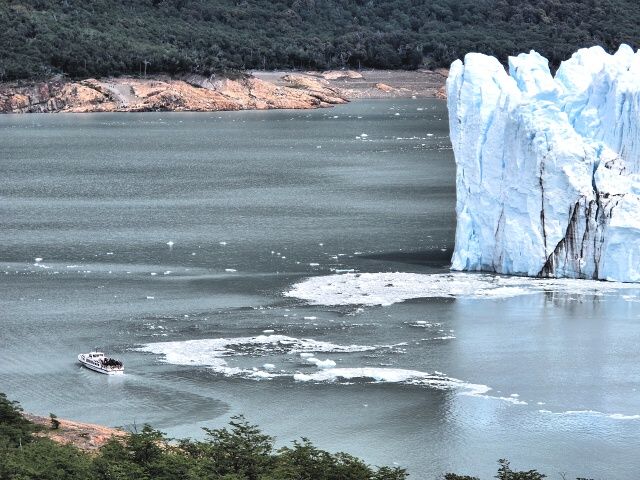
[Glaciar Perito Moreno] The glacier size in comparison to the boat carrying over 100 passengers
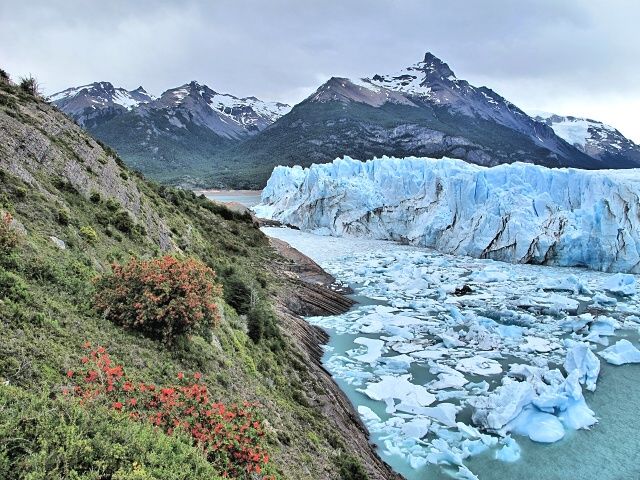
[Glaciar Perito Moreno] The opposite hillside covered with blossoms of Chilean “Fiery bush”
In the Arms of the Wind
After leaving Calafate, I was curious to see whether the wind would again be blowing so strongly and in the same direction, now very favorable to me. And I was lucky, I could not judge the strength of the wind, but its direction was the same. And so I sat up as straight as possible, setting my back to the gale and pedaled easily in the top gear at dizzying speed towards the intersection with Road 40. There, too, nothing had changed and I was soon 50 km further and had not even even started to sweat. Then began a challenging ascent from 300 to 900 meters, but the wind helped so much that even in the most difficult sections I did not have to pedal in the lowest gear.
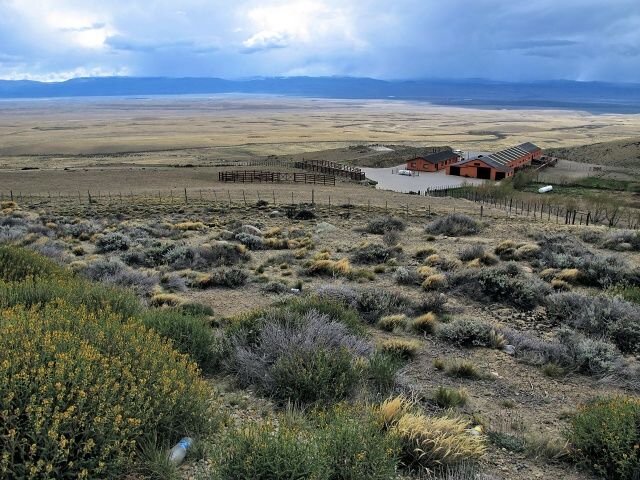
[Estancia Campamento] One of few farms on the road
Like the Germans at Stalingrad
This is how I felt at the top of the plateau. It had started to snow. The snow was heavy, rather like a hailstorm, and I was freezing, so I sought some shelter where I could put on warmer clothes. 5 km later the road passed through a gully, which screened the wind a little and I could put on all the clothing that I had. A ski mask warmed my head, the new Gore-Tex jacket bought in Santiago also worked well. The winter cycling pants had windstoppers only in front, so were a bit of a betrayal, because the wind was blowing from behind and blew right through the insulated pants without a problem. I managed to protect my hands with the combination of the windstopper gloves pulled over the llama woolen gloves. But the cycling sandals with thick socks remained a problem and my feet were really cold. So I was flicking my toes to get the blood circulating and to prevent frost-bite. After 40 km I got out of the bleak weather. Near El Cerrito, I turned sharply on to a dirt road and everything was different again. The bad road and headwind warmed me and I was hopeful of escaping from the low snow clouds which continued to haunt me.
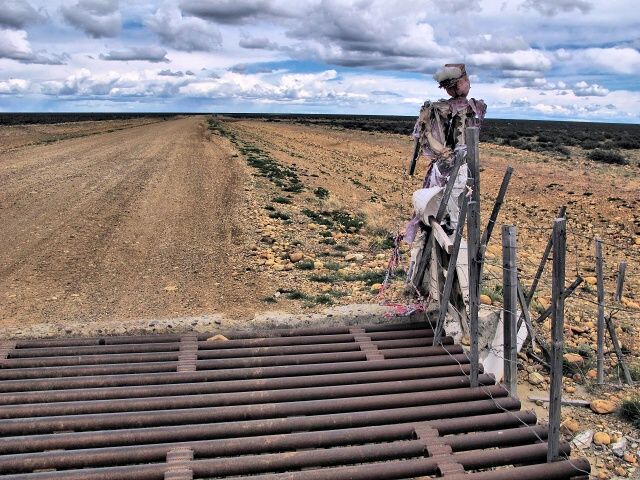
[El Cerrito] A diversion to the dusty road to Tapi Aike
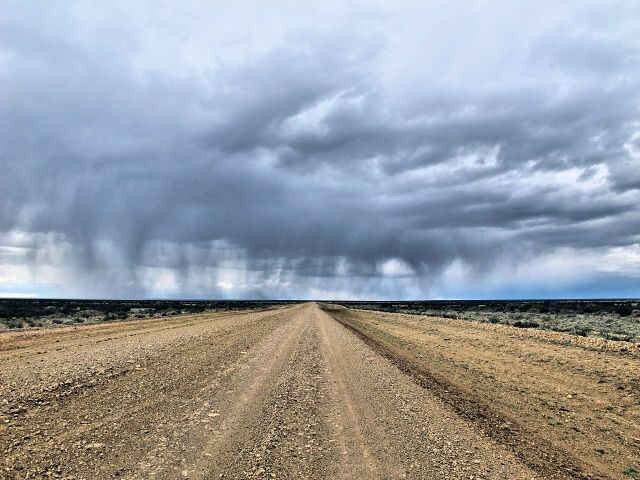
[Near El Cerrito] I was still followed by clouds full of rain and snow
Overnight at the Lousy Police Station
I knew that the road crossed the River Pelque, so I expected that I could sleep, wash and cook there. Cooking was not essential, I had prepared sandwiches with me, so it would be sufficient just to be able to make tea. Oh, but there was a house by the river with three people nearby, so I decided to continue to the next river which was about 9 km further on. I do not like to sleep in a place where others are aware of me. However, then I noticed that those people had bikes with bags and so I went over to them. They were three Belgian boys on the way from Ushuaia. They had wanted to sleep in the lee of the house, but the owner, possibly a part-time cop (the house was a Police station), was not home. Fortunately, he had left a note on the window of the Police station to say that he would be returning at about 7 p.m. It turned out well as he had no objections to us staying there. However, we first had to clean up the yard which was literally fouled by dogs and who knows what other animals, before we could pitch our tents. Cooking was quite a challenge. I did not have a practical windscreen for the MSR gas cooker, so the wind blew out the gas cooker flame all the time. I moved maybe five times before I found an almost windless corner. Yeah, the wind in Patagonia is no joke.
Against the Wind
The guys enthusiastically recounted that finally they had had the wind at their backs, so I knew what was waiting for me the next day. The dirt road was really bad, added to this was the headwind. I was looking forward to Tapi Ake, 70 km further on, where there should be a paved road and the opportunity to eat. The paved road really was there, but the food offer was limited to a minimalist kiosk at the gas pump, where only cola and biscuits were sold. At least I could stock up on drinking water. The attendant had to turn on the pump for this, but he did not protest, he had nothing to do anyway. While the road was good, the wind was even worse, thick as molasses, and I had to make my way through it for the next 30 km. Finally I saw a roadworkers' shed. I had passed it at first, but then realized that it would make the perfect windbreak. I returned, cleaned up a bit there, pitched the tent inside and, in the amazing windless interior, cooked my meal without a problem and slept contentedly.

[Near El Cerrito] A dusty road leading through the typical pampa; and the wind was blowing in my face
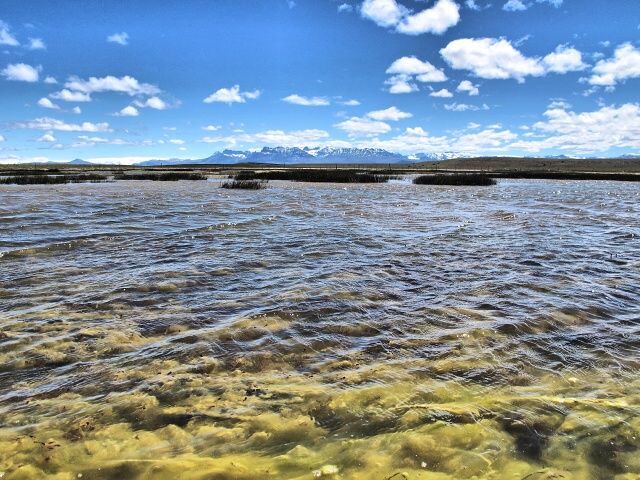
[Near El Cerrito] The mountain massif in the background in the Torres del Paine National Park
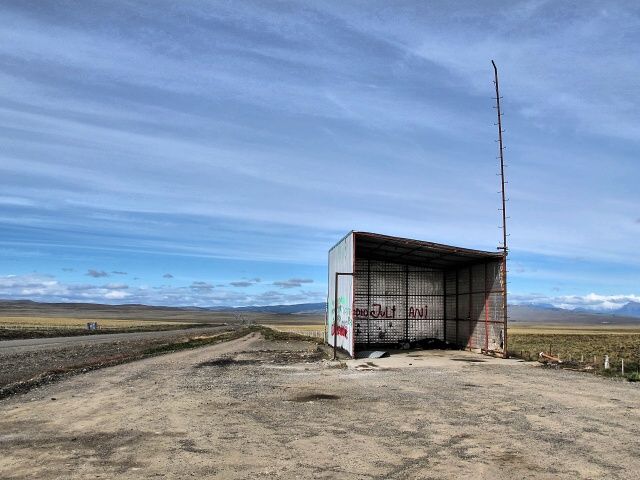
[Near Cerro Castillo] I pitched my tent in this roadworkers' shed to get away from the tiresome wind
There must be Order
The next day at dawn it was raining heavily, so I slept late. At about 9 a.m. it was only cloudy, so I dragged myself up, cooked breakfast and set off. And, oddly enough, where there had been a headwind the previous day, now there was a tailwind (as the English call it, referring to the tails of animals). Maybe it seems nitpicking to mention the wind changes, but for a cyclist this is a crucial factor. I passed through the Argentinean Customs without any problems, only a German tourist shouted at me to surrender my lighter. Immediately I realized that he had recognized the Czech flag and knew that in 2005 one Czech tourist cooking on a cooker in a strong wind had resulted in 10% of the Torres del Paine National Park being reduced to ashes. No witty answer came to mind, so I only said in Czech, “Go to Hell!”, and cycled to the 6-km distant Cerro Castillo to the Chilean Customs office. They are infamous there for disliking cyclists and motorcyclists. After passport control, I was sent to Customs where I had to fill out a form stating what I was not carrying on me. Then they said, “and now we will check it.” They came to the bike, examined the bag on the handlebars and then ordered me to take the three rear bags to the scanner. In the food bag I had expensive fruits and vegetables which could not be bought there and which I definitely did not want to be deprived of. So, while carrying the bags to them one by one, I opened the bag with the food and shoved all the problematic items under my jacket which I strategically hung over the handlebars. I will not allow myself to be robbed of vitamins. I had a great lunch at a good price. I bought expensive supplies for three days in the only mini store in Cerro Castillo , but, after seeing the prices in the kiosks, the National Park actually turned out to be very cheap.
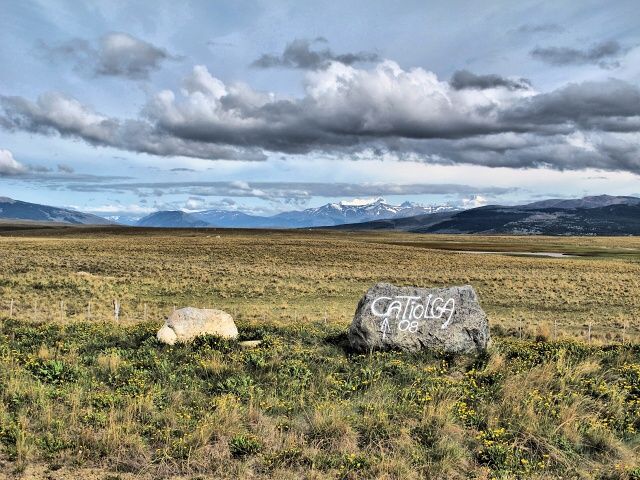
[Near Cerro Castillo] A view of the Torres del Paine National Park, quite far away
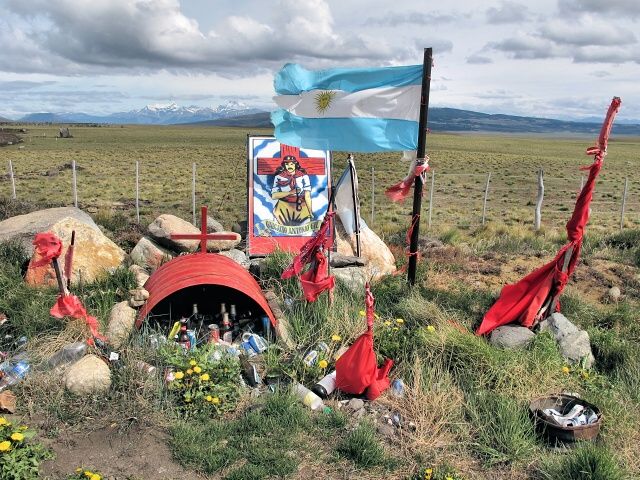
[Near Cerro Castillo] A small memorial by the roadside filled with bottles (I didn't check the contents)
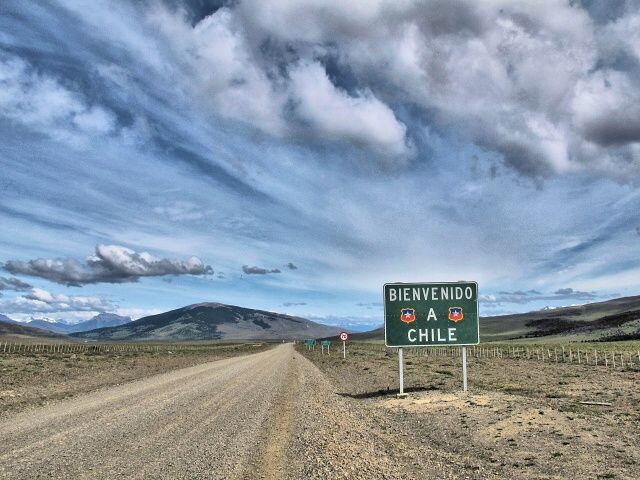
[Near Cerro Castillo] Back in Chile
On the way to the National Park, I met a French couple with their three-year-old daughter who were traveling from Usahuaia for about a month and would be on the road for an entire year. I do not fancy cycling with children in trailers. It is not enjoyable to sit for hours in a box on wheels, breathing in the fumes and smell from passing cars. But I discovered some necessary information about what was awaiting me. It started to rain heavily, the advantage was that the road was wet and passing cars stopped covering me with a layer of fine dust. I wanted to go to the Torres del Paine camp, but it was raining so heavily that I stayed overnight in the Laguna Amarga refugio. They wanted about 45 USD for a room which I refused to pay and opted for a tent site for 7 USD (4,000 Pesos). I pitched the tent in the rain and prevented the sleeping bag and ground sheet from getting wet. Of course, a toilet and shower were available to me. In fact, I camped out in the hostel corridor, dried out my waterproof pants and jacket, left my bags there and used the tent only to sleep in. There were also a couple of Polish cyclists who had arranged with the owner to sleep in the corridor for some baksheesh, as well as two orderly accommodated persons.

[Near Cerro Castillo] A French couple with their 3-year old daughter going places

[Near Cerro Castillo] The poor girl, daily enclosed in a bike trailer, breathing dust and car exhaust fumes for many hours
Trek in Sandals
The next day I cycled to the National Park, paid the 15,000-Peso entrance fee and reached the 10-km distant Torres del Paine camp (5,000 Pesos for a tent site). Before noon, I went on a very popular trail to the vista of three “towers”. It was not the season yet, but there were as many people as in Wenceslas Square. But I must proudly say that I was the only one in sandals. Many backpackers went to the Chileno camp, about an hour from the observation point, to camp out free of charge. Along the way, I chatted to the people I passed, after all, one moves easily without carrying much luggage. The tower peaks above soared into the clouds, the razor-sharp wind was blowing and occasionally it was snowing. I stayed there for about 20 minutes and then carefully descended. The upper part of the route led along broken stones and I had to take care not to damage my legs. Then again, a sandy slope and sandals are far worse for hiking downhill than uphill. However, I did it in five hours, whereas the normal time is seven hours.
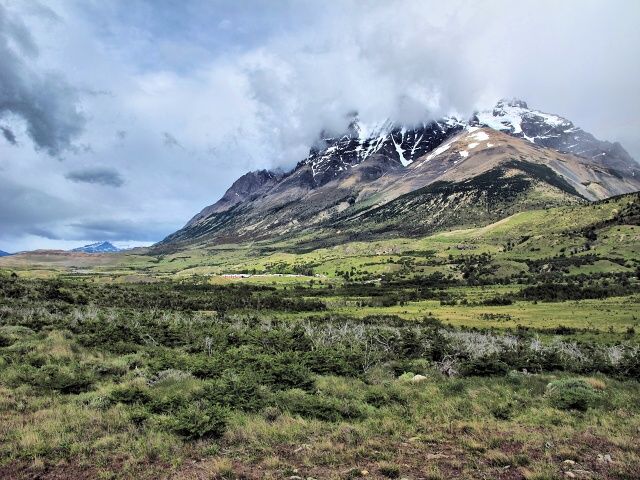
[NP Torres del Paine] The Torres del Paine Hotel and campsite at the foot of the mountain massif

[NP Torres del Paine] I liked this schematic depiction of the track with altitude and time data
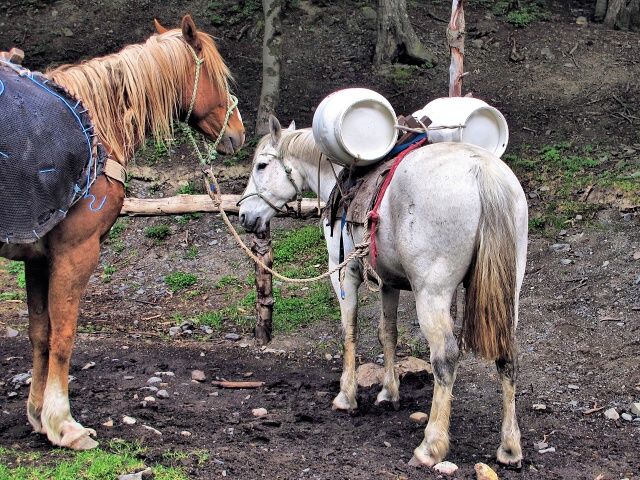
[NP Torres del Paine] Campamento Chileno is serviced solely by horses – the horse on the right carries empty propane and butane bottles, the one on the left carries garbage

[NP Torres del Paine] The horse convoy heading towards the valley for supplies
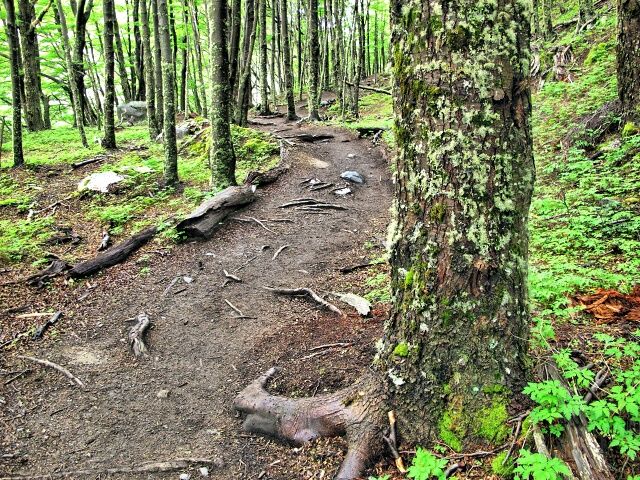
[NP Torres del Paine] The trail to the observatory “towers” led partly through the wood

[NP Torres del Paine] A waterfall on the opposite hillside while trekking towards the observatory “towers”
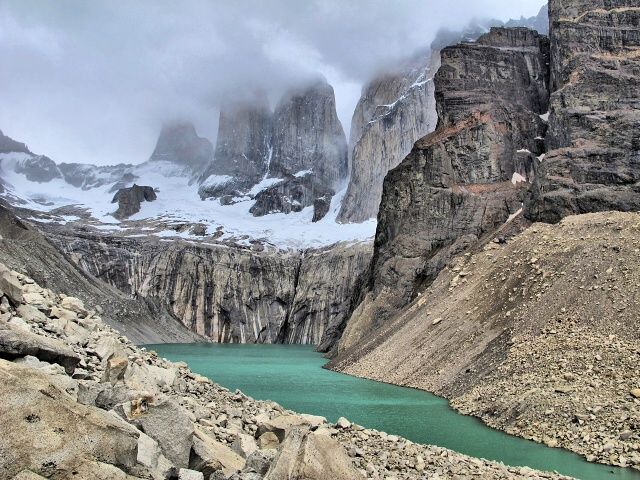
[NP Torres del Paine] The towers up to the clouds; at least something could be seen

[NP Torres del Paine] At the observation point there was a freezing wind and it snowed for a while
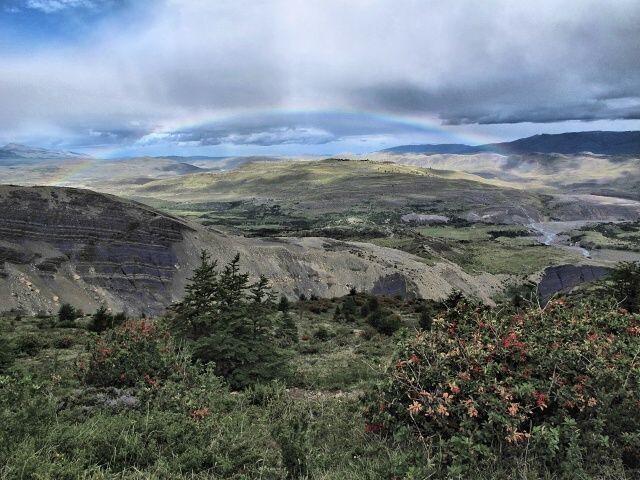
[NP Torres del Paine] The rainbow over the valley above the Torres del Paine camp
Route through the National Park
I enjoyed the following day and it was probably the best experience of the entire year’s journey. In particular, the plateau between Lake Nordenskjold and Sarmiento was really amazing. Lots of small lagoons, grazing guarnacas everywhere who were not afraid of me (interestingly, both sheep and cows are used to cars, but a bike always frightens them away). I saw a local fox and even photographed it not very successfully. I watched flocks of birds and gazed at the surrounding mountains. Despite being partially shrouded in clouds, they were simply beautiful. In the afternoon it started to rain, so I stayed in the campsite at Rio Serrano. The advantage was that there was a roofed shed with a table and benches on each site. So I could cook, regardless of the wind, and in the evening I even wrote a blog on the computer.
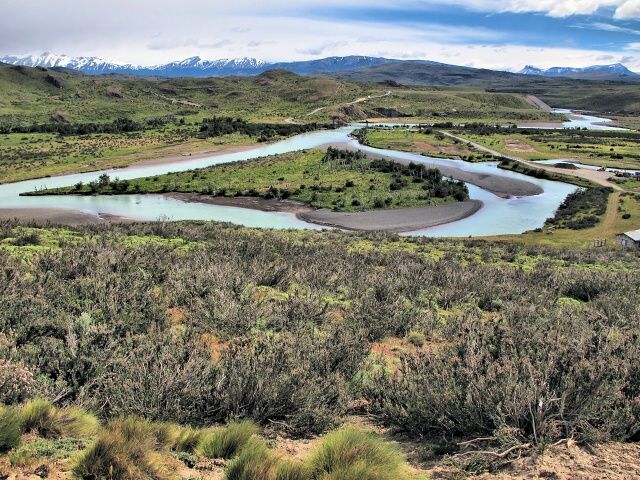
[NP Torres del Paine] A river flowing around the entrance to the National Park at Laguna Amarga
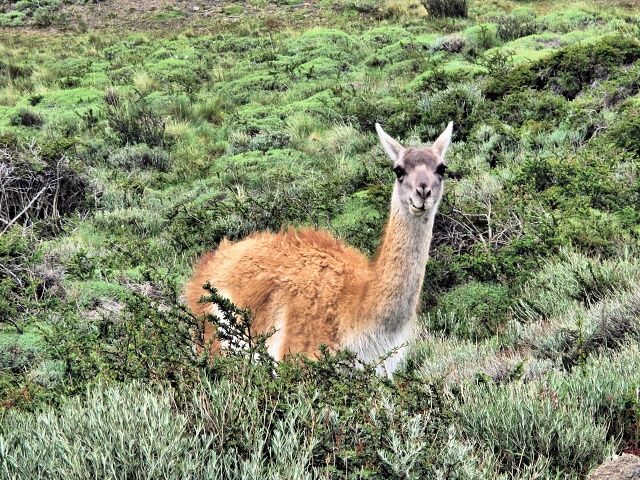
[NP Torres del Paine] It is hard to believe that guanacos once almost died out as a species
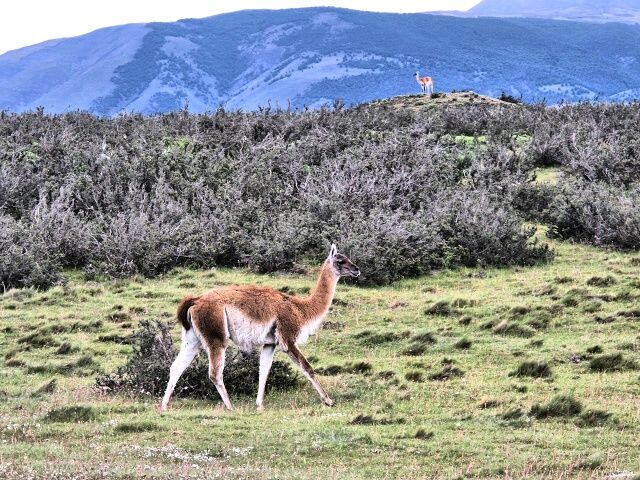
[NP Torres del Paine] A guanaco strolls along peacefully, while her colleague guards the mountain against puma

[NP Torres del Paine] A guanaco leaps over the road barriers
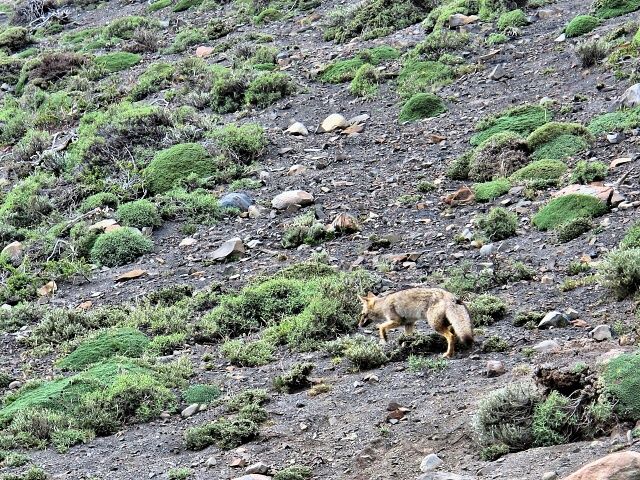
[NP Torres del Paine] A cunning old fox whizzed by in front of my camera
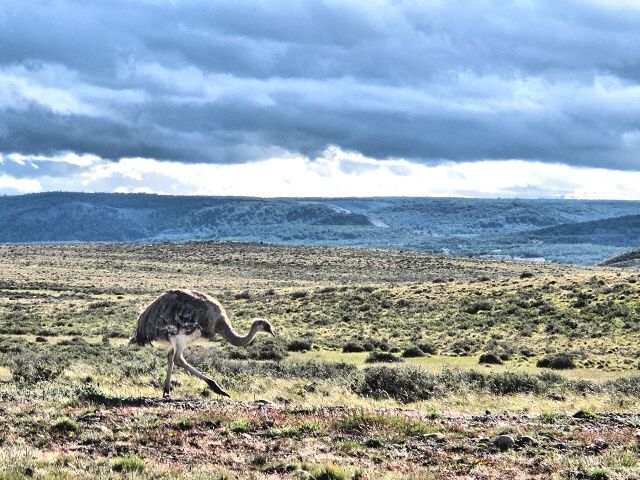
[Highway 9] Nandu – a local ostrich
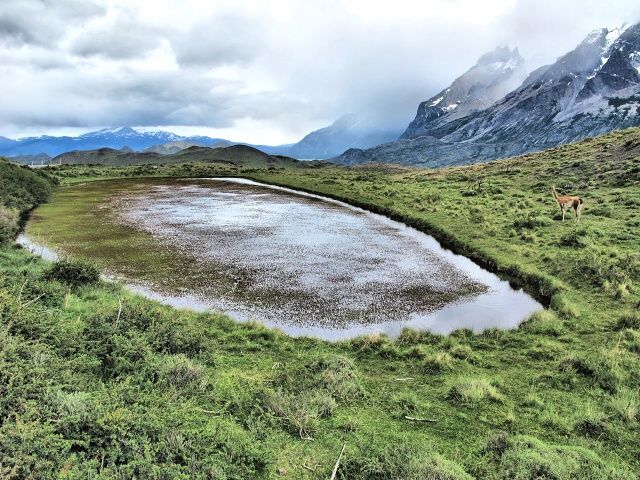
[NP Torres del Paine] There were plenty of small lagoons on the uplands

[NP Torres del Paine] You can see the nest in the reeds in the middle of the lagoon
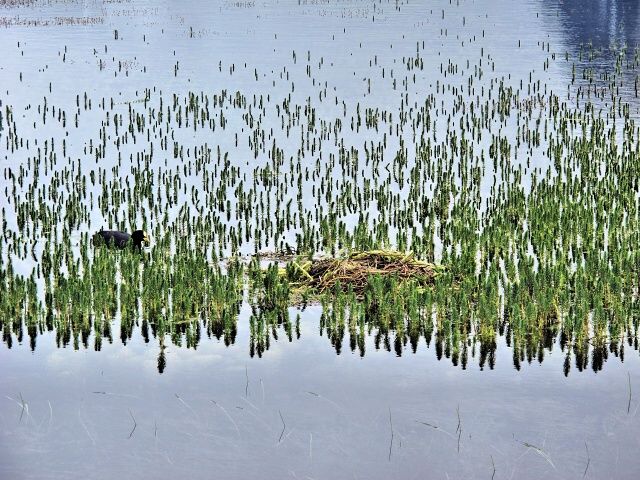
[NP Torres del Paine] A nest with a mother on guard

[NP Torres del Paine] Typical yellow vegetation
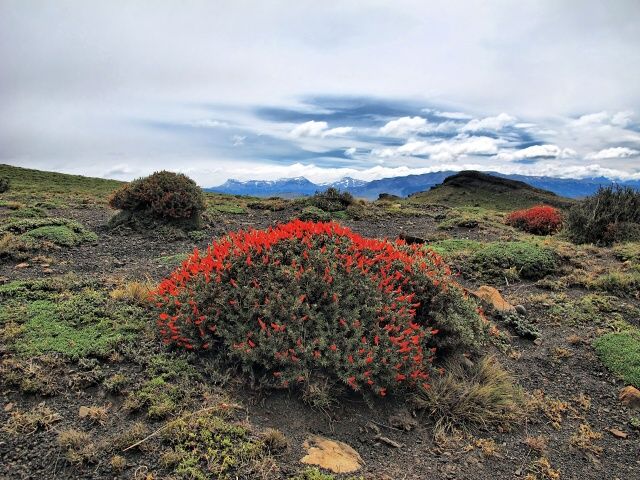
[NP Torres del Paine] The red colour livened up the fresh green meadows from time to time
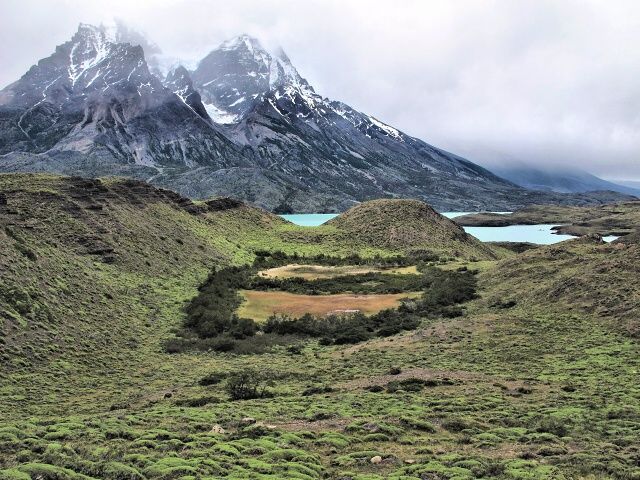
[NP Torres del Paine] Unbelievably blue Nordenskjold lake (it doesn´t sound very Spanish, does it?) in the background
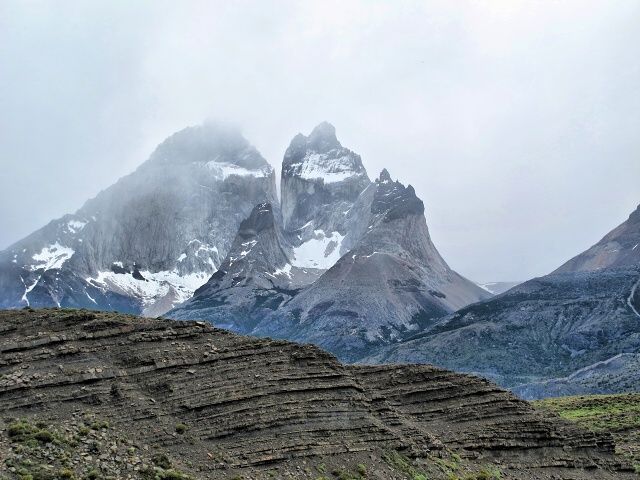
[NP Torres del Paine] Looking back at the massif with its “towers”
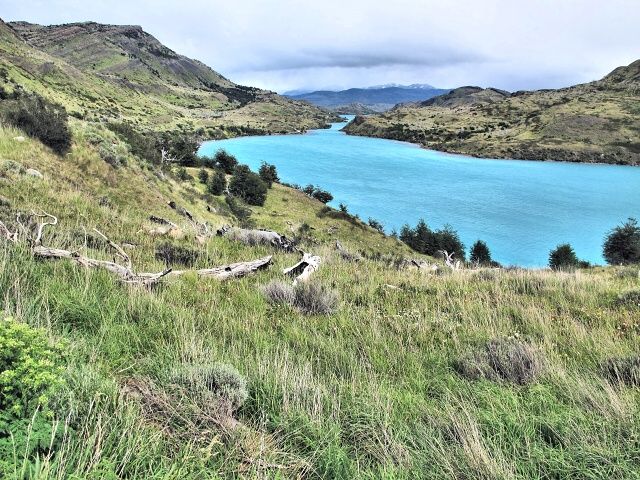
[NP Torres del Paine] The Paine river
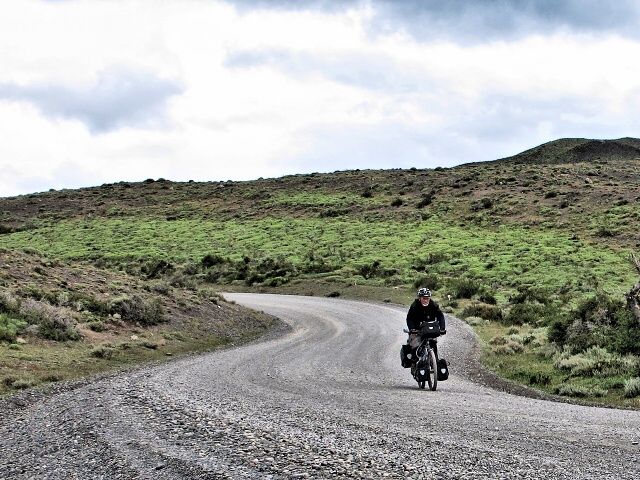
[NP Torres del Paine] I was going around like this
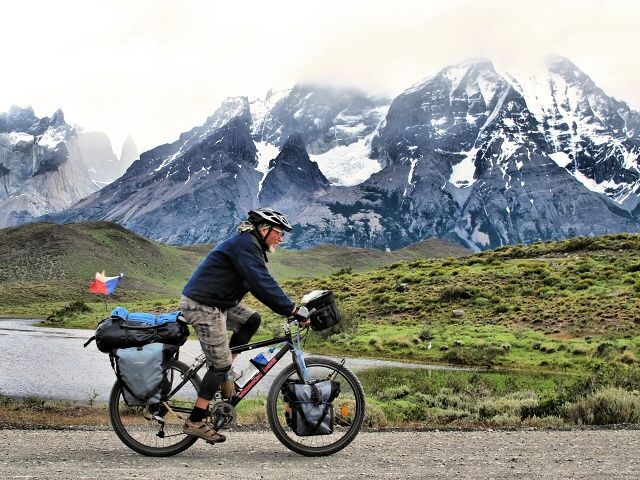
[NP Torres del Paine] At full blast
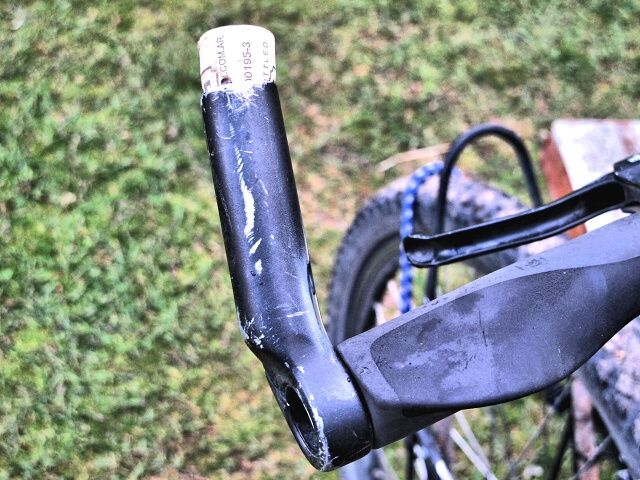
[NP Torres del Paine] Not only the pros, but most amateurs too were interested in some of my bike's innovations
Good Clothes withstand 24-hour Rain
It rained all night and in the morning continued with unprecedented intensity. It was a day when the the clouds were heavy and any hopes for improvement were far out of sight. Fortunately, the new Gore-Tex jacket bought in Santiago performed perfectly and even the pants impregnated at home did not get soaked through. The dirt road with a pretty lousy surface rose up and down, passing beside many mountain vistas, which unfortunately were hidden in clouds. In better weather, it must be something amazing. Towards evening, the rain ceased, but the wind remained very strong. All the time, it blew from the side. However, for the last 16 km along the beautiful paved road, it blew from behind and so I literally flew straight into Puerto Natales. First I went to the port, then to a restaurant for a delicious fish dinner and finally to the supermarket, where I was able to buy fruit, vegetables and my favorite Chilean red wine.
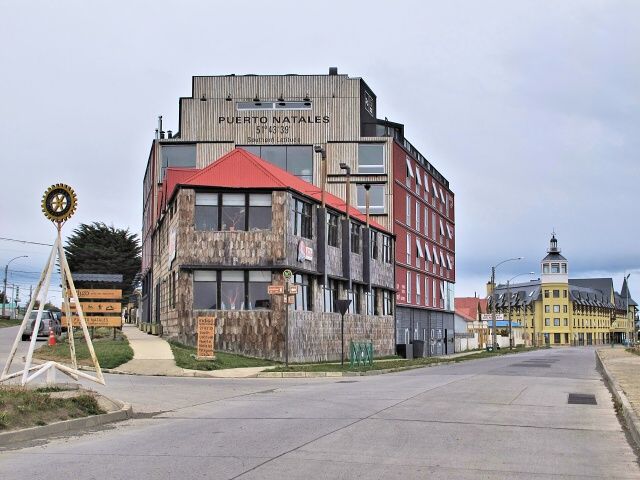
[Puerto Natales] The coastal road near the port
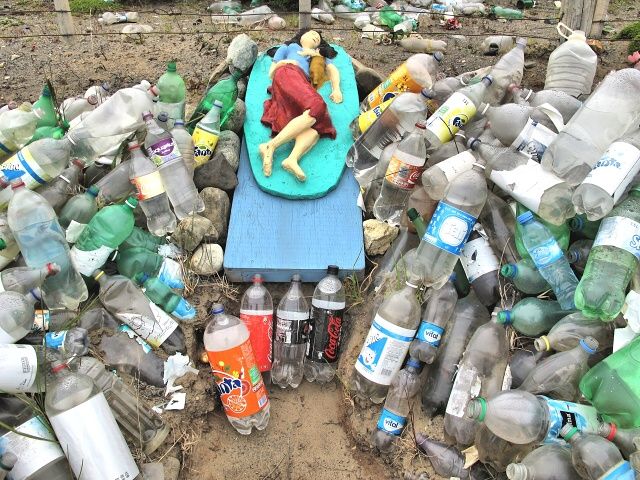
[Puerto Natales] A small memorial with a fallen girl decorated with plastic bottles
The Exception Proves the Rule
Road 9 from Puerte Natales to Punta Arenas is known for gale-force winds, which should be blowing from behind me. I had quite looked forward to it, but in vain. It was raining, completely windless, so I had to pedal as usual. I slept in the tent beside the road and the next day I at least ate a meal in Villa Tehuelches, the only large town on the route (about 40 houses). I went to see the local church and, when leaving, a local citizen came up to me and gave me a bag of freshly baked cakes. This really touched me. I waved thanks to his wife who was watching us from behind a curtain.

[Highway 9] A detail of the memorial by the road
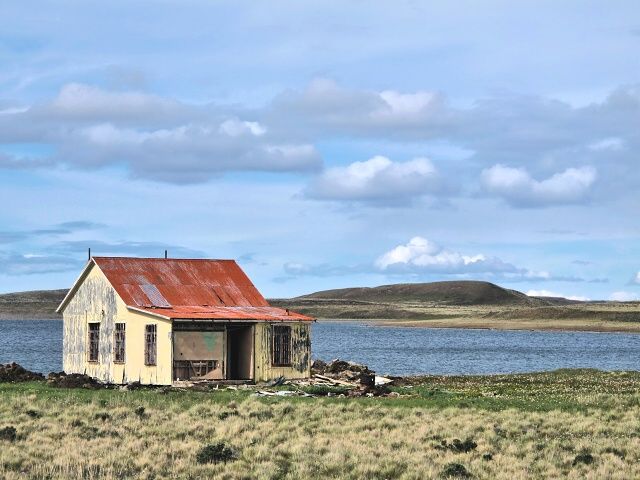
[Highway 9] A house at the bay
Otherwise, it was a tedious route with, except for the strange rock in Morro Chico, nothing much to be seen. And the rivers sadly disappointed me. In the GPS I had found some rivers where I would have liked to have slept. Unfortunately, they contained no water. The only variation were the memorials along the road and some car races about 20 km from Punta Arenas. I crawled through the fence, like many locals, and watched two races. And then everything went wrong. The heavy Sunday traffic forced me on to the non-reinforced verge, to avoid being run down. Half of the two-lane road was closed before the town, so everyone was driving bumper to bumper. Luckily I managed to cycle through most of the closure on the lane under construction. I stopped at the supermarket, arriving just before 7 p.m. Then the nightmare began – I went to about 15 hostels and all were full. At first I thought I was the problem – I stank, had a dirty face, horns and hooves, blood was squirting from me, or something like that. But then I realized that in four cases they were not open at all and only communicating through an intercom that they were full. Fortunately, I came across one owner who explained that the town was full of Argentineans and people who had returned from a trip to Antarctica and that on the following day everything would be OK. He gave me a map, told me to skip the center and showed me a district where I would have success. It had started to rain heavily, I did not want to go far from the center and thought that, when it got dark, I would pitch my tent on the shore, near the bike paths. Finally, I found accommodation at 9.45 p.m. (daylight only lasted until about 10 p.m.), but only in a four-bed shared room, where I was given the only free bunk bed and the very last bed in the hostel. But otherwise it was fine, there was WiFi and a kitchen, hot-water showers and a laundry. The next day I moved into a private room and everything was fine.
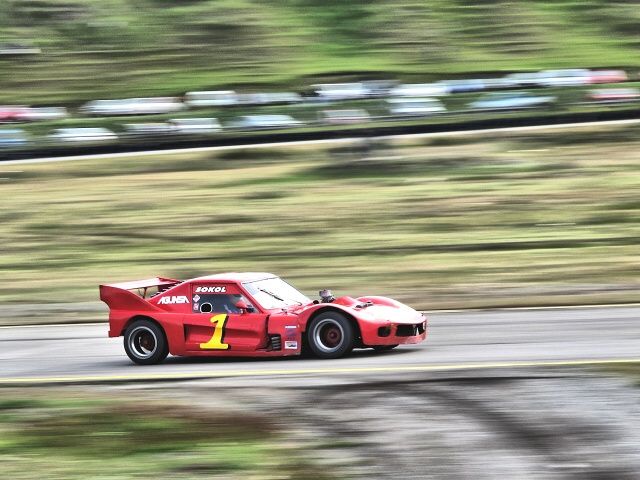
[Highway 9] A motor race
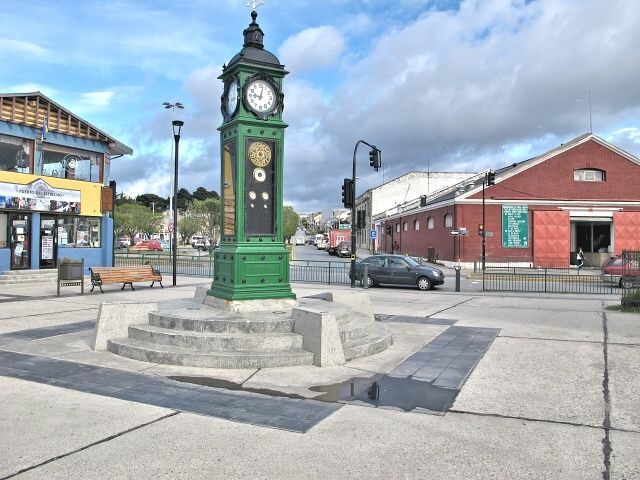
[Punta Arenas] A clock in the port
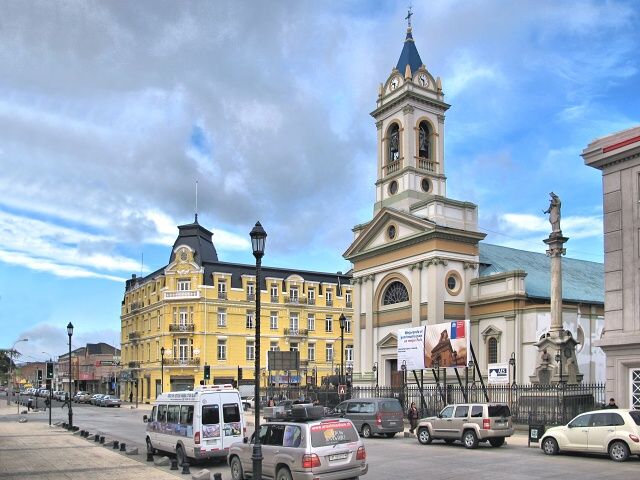
[Punta Arenas] Plaza de Armas
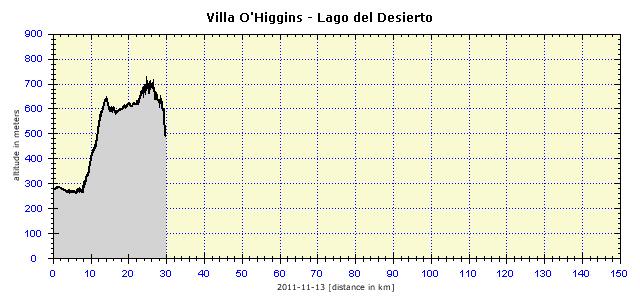

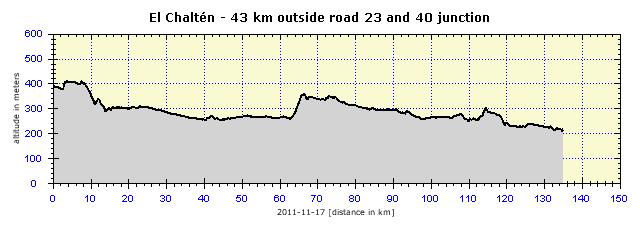

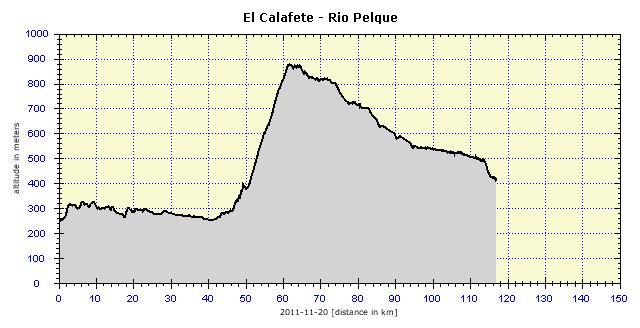







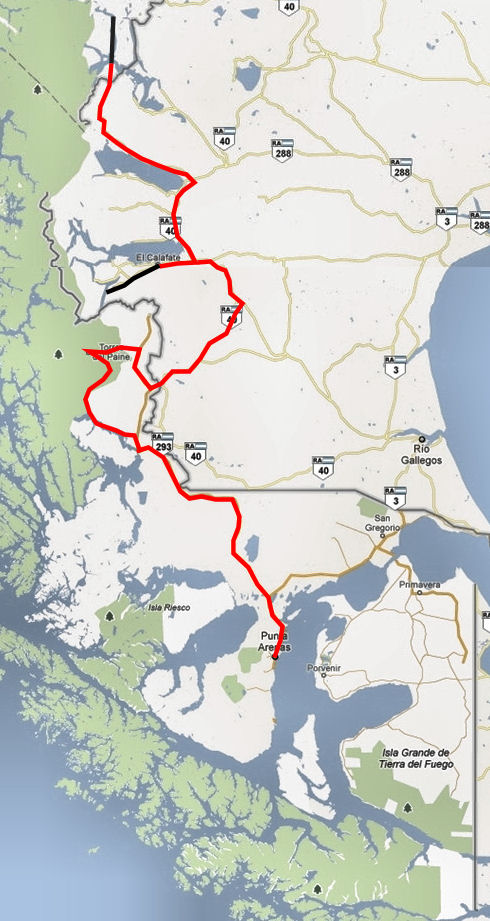
| 






































































































